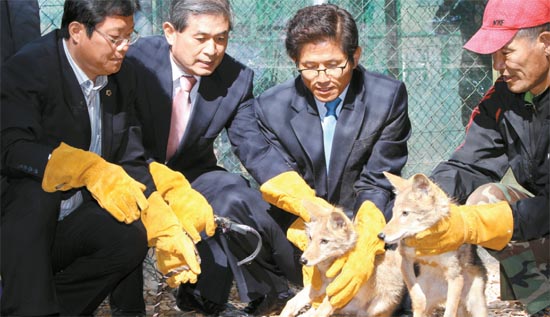Dishonored Hwang claims to have cloned eight coyotes

Stem-cell researcher Hwang Woo-suk, second from left, holds allegedly cloned coyotes with Gyeonggi governor Kim Moon-soo, second from right, at a farming facility in Gyeonggi yesterday. [YONHAP]
A Korean stem-cell researcher, Hwang Woo-suk, said that he has successfully cloned coyotes, a breakthrough that could help other species or even bring back extinct animals. Hwang and his research team confirmed yesterday they had cloned eight coyotes, which are the world’s first coyotes cloned using somatic cells.
Hwang, whose reputation was tarnished in 2005 after publishing a paper with false data, expects this result to accelerate his research on stem cells, but academic circles are apprehensive of the results as they are not yet verified.
Hwang and his research team at Suam Bioscience Institute in Gyeonggi said they cloned eight coyotes by transferring the nucleus of somatic cells from a donor coyote to eggs from a dog, and the embryos were then transferred to foster mothers, in this case dogs. The research team said the eight coyotes are the world’s first cloned using somatic cells, successfully cloning three females and five males.
The research team harvested a cell from a coyote in Cheongju Land, a public zoo in North Chungcheong, and incubated it into somatic cells for cloning. They made embryos by transferring incubated somatic cells into a dog’s egg, and then transplanted it into the dog’s uterus. The research team said that it could identify the cloned coyote’s pregnancy through ultrasound examination after 30 days of the transplant.
“We can increase the success rate of cloning up to 50 percent, whereas we only succeeded one time out of 1208 attempts when we cloned Snuppy in 2004,” a researcher at Suam Institute said “We extended our research work on dogs to coyotes.”
The research team said it initiated its first experiment on Feb. 19 and gained three female coyotes on June 17 and five males on June 30 by natural delivery. “The best gene analysis institution in Korea told us that the genes between the dogs, coyote, and the cloned coyotes are identical,” Hwang said. “Our research works’ result is currently being reviewed by one of the world’s most influential scientific journals.”
Hwang said he can’t declare the name of the journal as the verification is still going on. Hwang also said that he and his research team is working on cloning an African wild dog from dogs and will attempt to clone mammoths from elephants.
By Chung Young-jin [sakwon80@joongang.co.kr]
한글 관련 기사 [중앙일보]
“코요테 세계 첫 이종 복제” … 황우석, 재기하나
스너피 땐 1208번 중 1번 성공
“지금은 복제 성공률 50%” 주장
암컷 셋 수컷 다섯, 경기도 기증
학술지에 게재 안 돼 검증 필요
황우석 박사팀이 멸종위기에 처한 코요테 복제에 성공했다. 동종교배(同種交配)가 아닌 개의 난자를 이용한 이종(異種) 간 복제를 통해서다. 이종 간 복제는 산양과 양 사이에 있었지만 코요테-개 사이에서는 세계 처음이다.
2005년 줄기세포 논문조작 파동을 겪은 황우석 박사가 코요테 복제를 통해 재기의 기지개를 펴고 있다.
그러나 학계 일부에서는 코요테 이종 복제 성과가 학술지 등에 게재되지 않아 아직 연구 성과가 검증되지 않은 만큼 좀 더 지켜봐야 한다는 입장이다.
황우석 수암생명공학연구원 책임연구원은 17일 평택시 진위면에 있는 ‘경기도 축산위생연구소 야생동물구조센터’에서 복제 코요테 8마리를 경기도에 기증했다. 경기도와 수암생명공학연구원은 지난 6월 멸종위기 동물 체세포 복제 생산에 관한 연구협약을 체결하고 복제된 코요테 생산은 수암생명공학연구원이, 사육과 분양은 경기도가 각각 맡기로 했다.
황 박사팀이 이날 기증한 코요테는 코요테의 체세포를 개의 난자에 이식하는 체세포 핵이식 방법으로 복제한 것으로 암컷 3마리와 수컷 5마리다.
황 박사팀은 “2004년 복제 개 스너피를 복제할 때 1208번 시도 끝에 1번 성공했지만 최근에는 복제 성공률이 50%다. 개의 연구를 멸종위기 동물인 코요테에 확대 적용한 것”이라고 설명했다.
황 박사 팀은 지난 2월 19일 1차 실험을 했고, 6월 17일 암컷 3마리, 같은 달 30일 수컷 5마리의 코요테를 자연분만으로 얻는 데 성공했다.
황 박사는 “현재 관련 연구 성과를 세계적인 학술지에서 심사 중이지만 엠바고가 걸려 있어 학술지 이름을 공개할 수 없다”고 말했다.
한편 황 박사팀은 이날 “현재 아프리카 들개인 리카온 복제를 연구 중인데, 이종 간이 아닌 이속(異屬) 간 복제에 도전하고 있다”고 밝혔다.
◆코요테=개과 동물이다. 어깨 높이가 약 60㎝이고, 몸무게는 9~23㎏이다. 꼬리 길이 30~40㎝를 포함한 몸길이는 1~1.3m로 늑대보다 작고 가볍다. 등 쪽은 황갈색, 배 쪽은 흰색, 다리는 붉은색, 꼬리는 털이 많고 검다. 야행성으로 시속 64㎞로 달리며 사냥한다. 60~63일의 임신 기간을 거쳐 6마리 정도의 새끼를 낳는다.










with the Korea JoongAng Daily
To write comments, please log in to one of the accounts.
Standards Board Policy (0/250자)